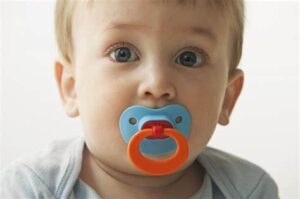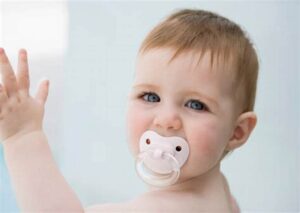Have you ever wondered about the long-term effects of pacifiers on your child’s teeth? It’s a common concern among parents and caregivers alike. The question “do pacifiers cause buck teeth?” often pops up in discussions around child rearing and dental health. With so much information out there, it’s crucial to separate fact from fiction. Today, we’re diving into the world of pacifiers, their impact on teeth alignment, and what this means for your little one. Let’s tackle these concerns head-on, shall we?
Understanding Pacifiers and Their Purpose

First off, what exactly are pacifiers? Simply put, they’re a parent’s best friend and a baby’s first companion. Designed to soothe and comfort, pacifiers mimic the natural act of sucking, providing a sense of security to infants. But they’re more than just a stopgap for calming cries. The benefits of pacifier use in young children are well-documented. From reducing the risk of SIDS (Sudden Infant Death Syndrome) to aiding in sleep training, the perks extend beyond mere comfort.
But here’s the million-dollar question: Are these benefits overshadowed by potential dental issues down the line? It’s a valid concern and one that we’re about to explore. Keep in mind, the goal here isn’t to alarm but to inform. After all, knowledge is power, especially when it comes to the well-being of our children. So, let’s dive in and uncover the truth behind pacifiers and their role in your child’s dental health. Are you ready to get to the bottom of this? Let’s go!
The Connection Between Pacifiers and Dental Health
Did you know that a child’s dental health starts to take shape long before their first tooth even appears? Yes, it’s true! From the moment they begin to use a pacifier, you’re setting the stage for their dental journey. But how does something as harmless as a pacifier tie into dental health, especially in young children? Let’s get into the heart of this puzzle.
Pacifiers and dental issues often find themselves in the same sentence. Why? Because the mouth is a dynamic landscape, constantly shaped by what’s in it. A pacifier, when used frequently, can be that unexpected guest that overstays its welcome, potentially leading to misalignment. But how exactly does this happen? It’s not magic, but rather a matter of pressure and habit.
Do Pacifiers Cause Buck Teeth? Unveiling the Truth
Onto the hot topic: do pacifiers actually lead to buck teeth? Picture the constant pressure on your child’s developing gums and teeth from a pacifier. It’s easy to imagine how excessive use might push those front teeth outward. But let’s not rush to judgment.
Research and expert insights shed light on this. Studies show pacifiers can lead to dental misalignments, like buck teeth, but it’s really about how often and how long they’re used. It’s not the pacifier alone but its role in daily routines that matters.
Pediatric dentists and orthodontists offer valuable perspectives. They’ve seen various cases and agree: pacifiers aren’t the end-all-be-all for dental problems. The key? Avoid prolonged, improper use. Balance, it seems, is crucial.
Seeing the full picture? Pacifiers do affect teeth alignment, but they’re not the only factor. It’s the duration, frequency, and usage method that count. Armed with this knowledge, you can make wise decisions about pacifier use.
So, don’t just ditch all pacifiers. Informed choices, guided by a bit of professional advice, can help you confidently manage this phase. Remember, a beautiful smile begins with smart decisions. Ready to rethink pacifiers? Let’s go!
Factors That Influence the Impact of Pacifiers on Teeth Alignment

Ever wonder why some kids seem unaffected by pacifier use, while others might face dental challenges? It’s not just luck. Several factors play a role in how pacifiers affect teeth alignment. Let’s break it down, shall we?
First off, duration of use is huge. Think about it: the longer a child uses a pacifier, the more likely their teeth might shift. Makes sense, right? But what about the type of pacifier? Yes, that matters too! Not all pacifiers are created equal. Some are designed to reduce dental risks. Have you checked yours?
Then, there’s the wild card: individual oral anatomy. Every child’s mouth is unique, like a fingerprint. This uniqueness means that the impact of pacifiers can vary greatly from one child to another. Ever thought about that?
Preventive Measures and Best Practices for Pacifier Use
Now, how can you swing the odds in your favor? Fear not! There are steps you can take to minimize any potential pacifier-induced dental woes.
Choosing the right pacifier is step one. Look for one that’s orthodontically designed. These are crafted to support natural oral development. Who knew shopping for pacifiers could be so strategic?
Next up, timing is everything. Experts recommend introducing a pacifier between 2 to 4 weeks of age and not beyond. And as for weaning? Aim to start saying goodbye to the pacifier around the 2-year mark. This timing helps avoid any long-term dental issues.
Speaking of weaning, it’s not just about picking a date. It’s about gradually reducing pacifier time, making it a gentle transition for your child. Ever tried swapping pacifier time with cuddle time? It’s a game-changer.
Lastly, keep an eye on your child’s pacifier habits. Is it constantly in their mouth, or just for sleep and comfort? Limiting use to naptime and bedtime can really make a difference. Did you think it would be that simple?
So, armed with these insights, are you feeling ready to navigate the pacifier phase with a bit more confidence? Remember, it’s all about informed choices, understanding your child’s needs, and maybe a little bit of strategy. Your child’s smile is precious, and with the right approach, you can help keep it that way. Ready to tackle pacifier use like a pro? I believe in you!
Alternatives to Pacifiers: Balancing Comfort and Dental Health
Looking for ways to soothe your baby without a pacifier? You’re not alone. It’s a common quest among parents aiming to balance comfort with dental health. So, what are the alternatives, and how do they stack up against pacifiers?
First, let’s talk about cuddling. Yes, good old-fashioned holding and rocking. It’s time-tested and incredibly effective. But is it always practical? Not necessarily. Yet, it’s unbeatable for bonding and has zero risk to dental health. Have you ever wondered if a simple hug could be the answer? Sometimes, it really is that simple.
Then there’s the option of teething toys. These come in various shapes and materials, designed to be gnawed on. They can offer relief, especially during teething, but choose wisely. Some are better designed for oral health than others. Ever thought about what goes into selecting the perfect teething toy? It’s more than just picking the cutest one.
Music and white noise are also fantastic alternatives. They can soothe a fussy baby without any physical intervention. Have you considered the power of a lullaby? Or the hum of a white noise machine? It’s amazing how sounds can calm and comfort.
But let’s weigh the pros and cons. Alternatives like cuddling, teething toys, and soothing sounds lack the potential dental risks of pacifiers but may not always be as immediately effective in calming. Ever been in a situation where nothing but a pacifier would do? It’s a tough call.
Professional Insights: When to Consult a Pediatric Dentist

When should you actually worry about pacifier use and dental health? It’s a question that haunts many parents. The truth is, professional guidance is invaluable. But what are the signs that it’s time to seek out a pediatric dentist?
If you notice changes in your child’s bite or the alignment of their teeth, it’s time. Have you seen their front teeth starting to look different? Or maybe their bite doesn’t close properly? These could be early warnings.
A pediatric dentist can offer personalized advice and assessments. They’re not just there for problems but for prevention too. Ever thought of a dentist as a preventive health warrior? Well, in the world of pacifiers and teeth alignment, they certainly are.
Don’t wait for obvious signs of dental misalignment. Regular check-ups can catch potential issues long before they become problematic. Have you scheduled your child’s next dental visit? It’s not just about cavities; it’s about ensuring that pacifier use isn’t leading to bigger issues.
Remember, every child is unique, and so is their dental journey. Whether you’re exploring alternatives to pacifiers or seeking professional advice, you’re taking important steps toward preserving your child’s smile. Ready to embrace these strategies with confidence? Your child’s dental health is worth it!
Making Informed Decisions About Pacifier Use
So, what’s the bottom line on pacifiers and buck teeth? It’s clear they can have an impact, but it’s not all doom and gloom. Remember, it’s about how and when pacifiers are used. Have we demystified the pacifier puzzle for you?
We’ve explored alternatives and highlighted the importance of moderation and mindful use. Ever considered how a simple change in routine might safeguard your child’s smile? It’s definitely food for thought.
The key takeaway? Balance is essential. Pacifiers offer comfort, but their use requires careful consideration to avoid dental issues down the line. Have you thought about how to strike that perfect balance?
We encourage you to weigh the benefits against the potential dental risks. Making informed decisions means looking at the whole picture. Are you ready to make choices that blend comfort, convenience, and dental health?
Let this be your guide to navigating pacifier use with confidence. Remember, you’re not alone. Seeking professional advice and staying informed are your best tools. Ready to take on the pacifier challenge with new insights? Your child’s beautiful smile is in your hands!
Ready to Take the Next Step? Let’s Talk!
Curious about how pacifier use might be impacting your child’s dental health? Or maybe you’re looking for personalized advice on balancing comfort with dental wellness? It’s time to get the answers you need.
Don’t let uncertainties about dental health keep you up at night. Our team of pediatric dental professionals is here to guide you through every concern, big or small. Whether it’s time for a check-up or you have specific questions about pacifiers and teeth alignment, we’re ready to help.
Connect with us today and take the first step towards ensuring your child’s smile stays bright and healthy. We’re more than just a dental practice; we’re your partners in parenting. Let’s make informed dental health decisions together. Your child’s smile is worth it!

